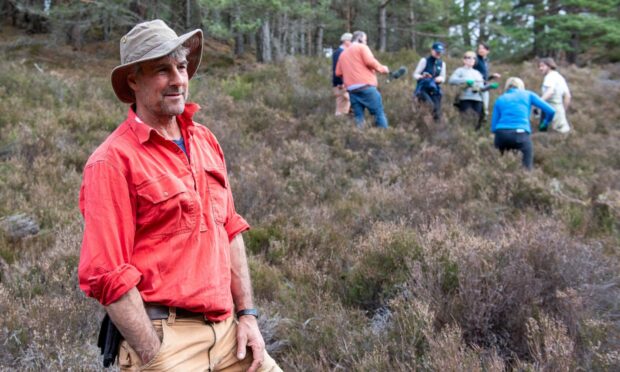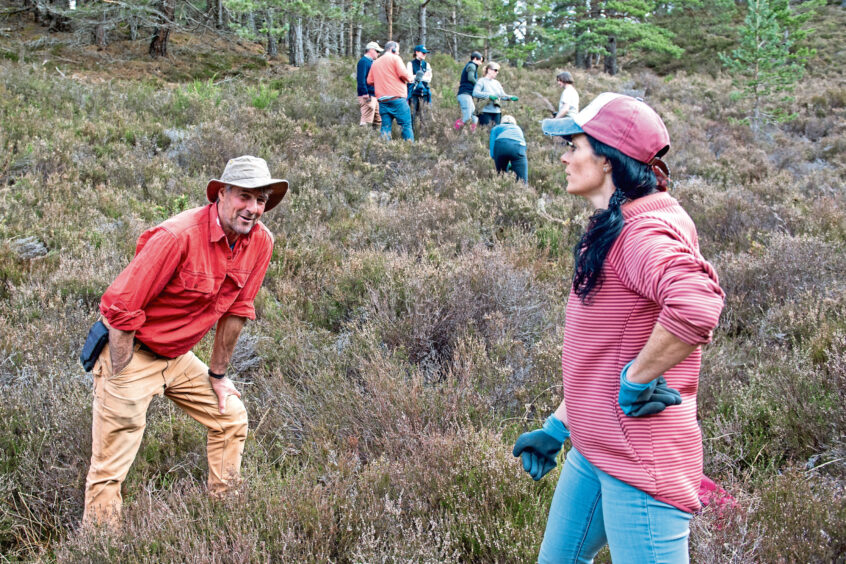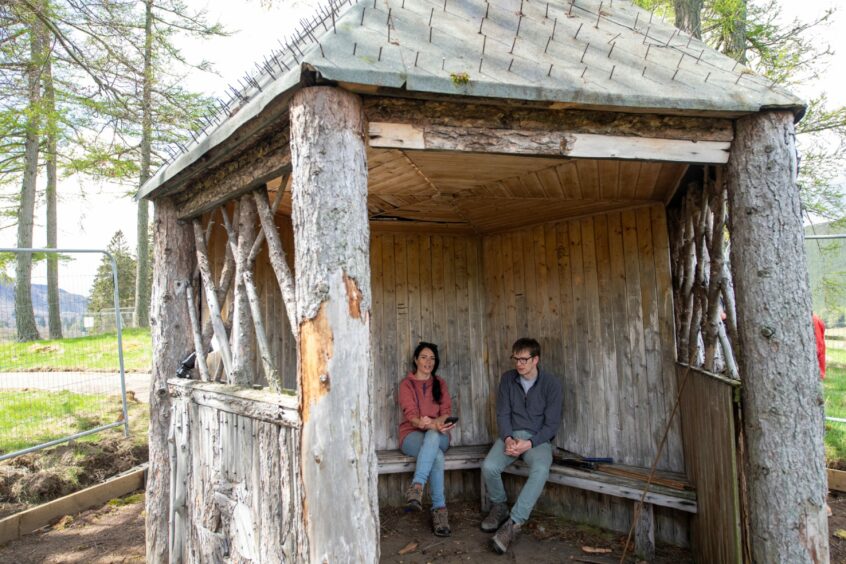Gayle joins volunteers as they harvest heather from Invercauld Estate to re-thatch a unique ‘fog house’ in the grounds of Braemar Castle.
Gazing out at the dramatic Deeside landscape from inside the rather dilapidated “fog house”, it’s easy to see why the once-pretty garden folly was positioned here.
The views down the Dee valley and across to Invercauld House are stupendous – you could easily while away the hours just sitting here, contemplating nature.
It’s thought the fog house was erected here in the 18th Century, as a decorative garden feature in the grounds of Braemar Castle.
When I visit, it’s in a very sorry state, with rotting timbers and barely any of the original heather thatch left on the roof.
Luckily, there’s funding in place to revamp the structure, as part of a major renovation project of the castle headed up by land and estate agents Bell Ingram.
Conservation architect Iain Cram, head of design at Bell Ingram, reckons the fog house was restored, “although not very traditionally”, about 20 years ago.
“It has the potential to be a pretty folly in the grounds of the A-listed castle,” he says.
“When you sit in it, and look at the view, you go: ‘Ah, that’s why it’s here.’ But it’s actually quite a complex restoration.
“There’s so little sound, original timber left so it’s a real jigsaw trying to save the good bits without binning it all and starting again. We’ll save what timber we can.
“It was just built out of bits and pieces – offcuts, sawmill waste, timber with bark left on it – but that makes it charming.”
Re-thatching
The roof was originally heather-thatched, and the job of re-thatching is down to Ullapool-based Brian Wilson and his apprentice Troy Holt.
It’s a lost art. It’s labour intensive and there are precious few heather thatchers in Scotland these days.
So why heather? Iain reckons it was probably aesthetic.
“It was built to be attractive,” he muses.
“They had easy access to slate, if they’d wanted to use it, but the Victorians liked to make things look older than they were – it’s a ‘ye olde’ garden folly.
“They chose heather because it was traditional, not because they didn’t have options.”
Harvesting heather
There’s a lot of work to be done before Brian and Troy begin. Vast quantities of heather need to be harvested, for starters.
Luckily Brian has found a secluded wooded area a few miles from the folly where it grows in abundance.
It’s here that I meet him and a group of volunteers picking heather galore. I’m keen to get stuck in, although ripping it out is harder than it looks.
“I’d rather you took your time and choose good stuff,” Brian tells us. “It’s not all usable.
“We need really good-quality, straight-running heather with a decent amount of frond on it.
“It’s a case of getting to the bottom of the plant with two hands, and your foot at the base of it, and then pulling it out.
It’ll come out with moss on the tails, so you’ll need to clean that off.”
Hard work
It’s hard work, and I’m not convinced I’m finding the “good stuff”, so it’s reassuring when Brian gives me his seal of approval.
“We’re looking for about 60 or 70 bundles about the size of a ‘hug’,” he grins.
Once the volunteers have collected this amount (I can’t stay here picking all week, alas!), Brian and Troy will re-thatch the structure in layers.
“There’ll be a new layer of felt and batons on the roof, and we’ll thatch it onto these,” explains Brian.
“We’ll start with a nice overhanging layer round the eaves, a sort of skirt round the whole thing.
“It’ll be like an overhanging Hawaiian skirt sort of effect. Then we’ll bring it up to a conical peak, so it’ll have an ornamental top.
“If the layers of heather are thick enough and tight enough, it’ll easily shed water.”
With a bit of maintenance, Brian reckons the thatch could last about 20 years.
Rare art
Unsurprisingly, he’s keen to see the rare art of heather thatching kept alive.
“There’s an opportunity for new blood in the game – I won’t be around for the next 40 years!” he smiles.
“By the time the fog house is needing repaired, it’ll be someone else doing it!”
So why is it called a fog house? Nobody seems to have a definitive answer.
It seems the word “fog” derives from the Scots word for the moss that was a major feature of such buildings, mainly used to line the walls and roof.
Fog house
“Fog – it probably means ‘mossy heather’,” says Brian. “Those things grow together on the hill. But I think ‘fog’ is a fairly local term.”
It’s an adorable wee building, and the name just adds to its evocative appeal.
While there’s a curved wooden bench to sit on inside, Iain reveals the flooring is made of offcuts from flagstone inside Braemar Castle.
“The whole thing is built out of scraps – rubbish to the Victorians,” he muses. “It looks twee and pretty to us, and it did to them, too.
“The castle marks its 400th anniversary in 2028, and reopens to the public in August, so it’ll be nice to see the grounds, including the fog house, looking their very best!”
- Brian Wilson is a heather thatcher and dry stane dyker based near Ullapool but with work all over Scotland and beyond. He’s currently also working on a new thatched roundhouse at the Scottish Crannog Centre in Kenmore, Perthshire, plus he’s restored turf houses across Iceland.






